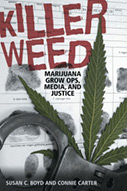Killer Weed: Marijuana Grow Ops, Media, and Justice

Authors: Susan C. Boyd and Connie Carter
Publisher: Toronto: University of Toronto Press, 2014. 204p.
Reviewer: Rebecca Jesseman | March 2016
What comes to mind when Canadians think about grow-ops? Cheech and Chong, the Hells Angels, or an angry loner in a booby-trapped barn? Killer Weed sets out to illustrate how the media has contributed to the social construction of marijuana grow-ops, drawing on a study of articles on the topic found in four Canadian newspapers between 1995 and 2009. At just over 200 pages, the book provides an approachable exploration of the issue across social, criminal justice, and civil policy domains. The book’s first few chapters cover considerable ground in setting the stage in terms of purpose, theoretical and methodological approach, and the broader social and criminal justice context of marijuana use and policy history. This is useful for those approaching the book from an academic perspective, or without a background in the area of drug policy. The book moves more quickly and becomes increasingly approachable as it proceeds from theory to application, using the initial sample of media articles to support and illustrate the author’s critical perspective but certainly going far beyond simple data presentation. The authors contextualize the issue of grow-ops within the broader social and criminal justice context, at times diverting into relatively in-depth critical evaluation of the criminal justice system independent of direct linkages to the subject of the book. The media’s contribution to the racialization of marijuana is a recurring theme; from its appearance on the political agenda in the early 20th century to the present. The presentation of the shooting deaths of four Royal Canadian Mounted Police (RCMP) officers in Mayerthorpe provides an interesting exploration of how inaccurate communication can have a lasting impact on public perception. The authors also illustrate how the stigma and false perceptions created by the media in relation to grow-ops has contributed to the creation and acceptance of intrusive civil and criminal processes that impact all Canadians.
The authors very convincingly make the case for the one-sided perspective resulting from the media’s reliance on a small selection of privileged claims-makers, notably enforcement, fire services, and a particular researcher with whose work they repeatedly take issue. A key finding of the authors’ work is the media’s consistent reliance on a small sample of sources, resulting in the establishment of fact through repetition and circular reasoning. This is driven poignantly home by examples where government, enforcement agencies, and media are repeatedly quoting one another on ‘facts’ that have no actual basis in concrete evidence. The authors’ exploration of the gaps in knowledge relating to marijuana production and use are illustrative of the media’s focus on attention versus accuracy, and politics versus evidence. The point is also well made that a limited number of perspectives has not only restricted the understanding of the problem, but also restricted the scope of solutions put forward.
Overall, the book succeeds in providing a critical lens on the social construction of marijuana grow-ops. It leaves some questions that could perhaps be answered by going back to the initial study; for example whether the media’s sensationalistic approach to grow-ops is disproportionate to the approach taken to other social issues, or simply part of an overall trend toward exaggerated headlines that play on public fears. On a final note, the book’s thorough referencing provides an excellent resource for readers looking to further develop their understanding of marijuana or drug policy more broadly.
Rebecca Jesseman, Research and Policy Analyst, Canadian Centre on Substance Abuse


